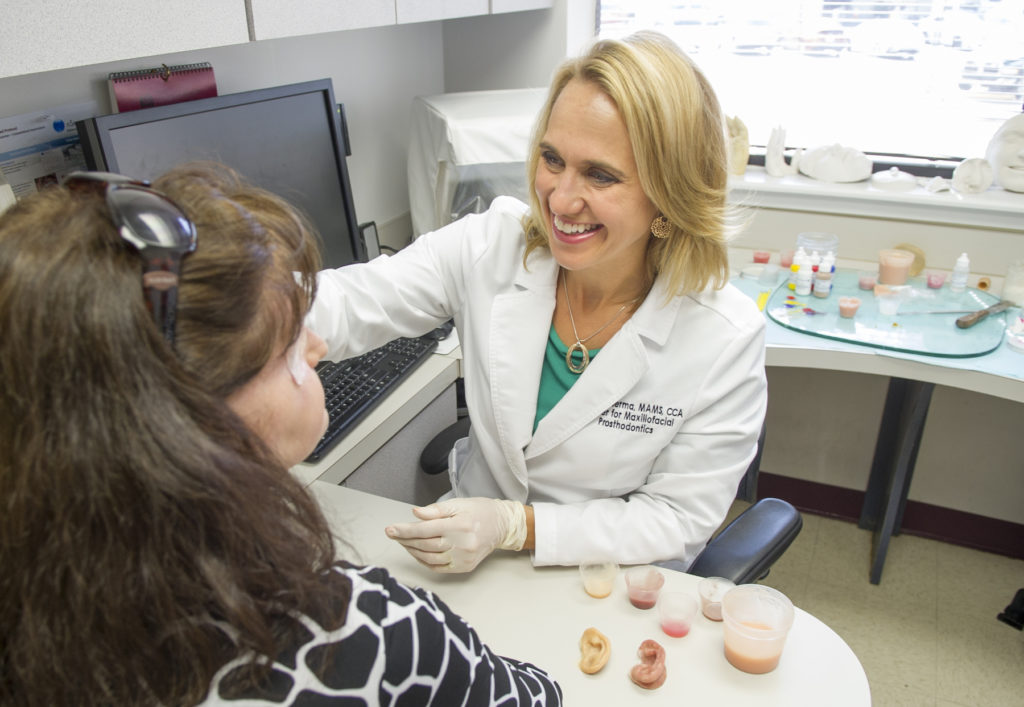SAN JOSE, California — Until recently, when preparing to operate on patients’ faces or heads, surgeons had to imagine how 2-D CAT scans stacked together to create 3-D skulls. Now, with 3-D imaging software, there’s no imagination required, and that technology can help with everything from planning surgery to identifying human remains.
Three medical researchers spoke Friday at the AAAS Annual Meeting in San Jose about the ways that digital techniques enable surgeons to construct new faces for patients in need.
Suzanne Verma, an assistant professor at the Texas A&M University Baylor College of Dentistry, uses a collection of software tools to design and construct facial prosthetics for people who have been through massive trauma.
“The restoration of self-esteem really is our ultimate goal,” Verma said at a 13 February symposium.
She described the case of Billy Crawford, who arrived at a hospital complaining about pain in his face. Within four and a half hours, the skin between the middle of his forehead and upper lip had turned a necrotic black. He had a fungal infection, exacerbated by the chemotherapy he received for his cancer. His compromised immune system meant he couldn’t receive a facial transplant.
Crawford lost an eye and much of his nose when doctors removed the infected tissue. But fortunately he’d had a 3-D CAT scan done when he first got to the hospital.
Taking a second scan of Crawford’s face and comparing it with the original helped Verma pinpoint the spots that magnetic implants could be inserted into his bone as anchors for a future prosthetic.
“Basically I can give the surgeon six or seven choices for the implants,” Verma said. “I’ll then save this on a USB drive with any notations or measurements, and we’re ready to go right into the OR.”
During surgeries such as the one Crawford underwent, a system of cameras and infrared lights tracks the surgeon’s instruments, a technique called navigational surgery. It combines the image data and Verma’s plan to provide the surgeon with a more complete picture, speeding up the operation.
“You can definitely see which residents spend their time playing video games,” Verma said.
With the anchors in place, the last step is to design a prosthesis that approximates the patient’s pre-trauma face. Once done, the design can be sent to a 3-D printer for fabrication and later painted to match details like age spots and freckles.
But 3-D imaging doesn’t just enable prosthetic design.
Pravin Patel, a professor of surgery at the University of Illinois in Chicago who operates on children with birth defects, stressed the importance of 3-D imaging for teaching future surgeons. He described the advantage in operating room terms.
“The practical problem is this,” Patel said. “You’re in the operating room with a resident. How do you teach that resident where to make bone cuts?”
The best method used to be a pencil and an exposed skull. Patel would argue with his residents about the right cuts to make, but often he didn’t have persuasive evidence to justify his choice.
Now, with an iPad or laptop, Patel can make virtual cuts in a digitized version of a child’s malformed skull and then reassemble the bone fragments. For any gaps, he can fabricate pieces that perfectly fill the space. He likened it to slicing up a football and reassembling the pieces to make a soccer ball.
“The art of surgery is knowing where to put those pieces,” Patel said.
Three-dimensional imaging techniques can also be used for dentistry and forensics. This is especially true now that the technology is more widely available, said James Mah, an orthodontist at the University of Nevada, Las Vegas.
“It used to be reserved for the research environment ‐ the unique cases,” Mah said. “But it’s now available for more common patients that come in with orthodontic needs.”
Mah has other ideas for these imaging applications besides braces.
“Unfortunately in Las Vegas there is some truth to the urban legend that there are skulls in the desert,” he said.
One day, a representative from the coroner’s office visited Mah with the skull of a child and asked if he could help with the identification. He estimated the age based on the teeth but wondered if there was something more he could do.
Mah had already scanned each of his patients and recorded the position of certain facial and dental features, so he developed a technique to compare skulls by analyzing these signatures.
“It’s a unique pattern,” he said. “It involves their teeth and the skeleton. It’s like their skull fingerprint.”
A database with hundreds of thousands of faces could aid law enforcement in identifying human remains, Mah said.


